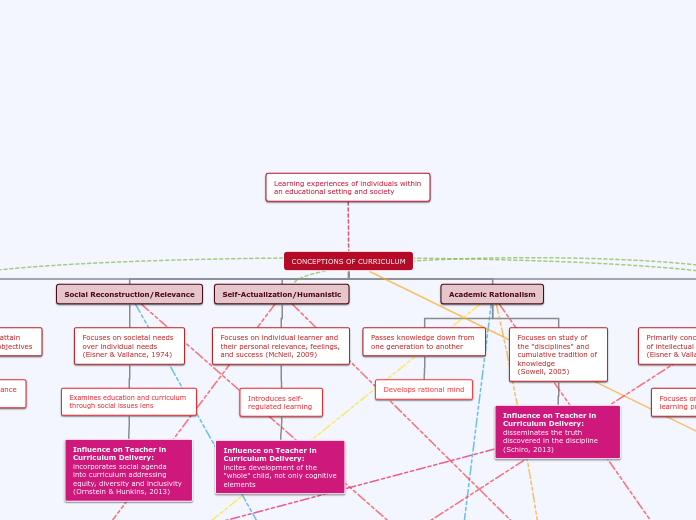CONCEPTIONS OF CURRICULUM
Curriculum as Technology
Focuses on the 'how' of education (Eisner & Vallance, 1974; McNeil, 2009; Sowell, 2005)
Influence on Teacher in Curriculum Delivery:
focuses on presenting material rather than focusing on the student as individual
Uses technology to attain curricular learning objectives
Growing importance in education
Social Reconstruction/Relevance
Focuses on societal needs over individual needs (Eisner & Vallance, 1974)
Examines education and curriculum
through social issues lens
Influence on Teacher in
Curriculum Delivery:
incorporates social agenda
into curriculum addressing
equity, diversity and inclusivity
(Ornstein & Hunkins, 2013)
Self-Actualization/Humanistic
Focuses on individual learner and their personal relevance, feelings, and success (McNeil, 2009)
Introduces self-regulated learning
Influence on Teacher in
Curriculum Delivery:
incites development of the "whole" child, not only cognitive elements
Academic Rationalism
Passes knowledge down from one generation to another
Develops rational mind
Focuses on study of
the "disciplines" and
cumulative tradition of
knowledge
(Sowell, 2005)
Influence on Teacher in
Curriculum Delivery: disseminates the truth discovered in the discipline
(Schiro, 2013)
Cognitive Processes
Primarily concerned with refinement
of intellectual operations
(Eisner & Vallance, 1974)
Focuses on the child and the
learning process
Influence on Teacher in Curriculum Delivery: engages student in critical thinking and rationale building, developing their intellect
PHILOSOPHICAL FOUNDATIONS
Perennialism
Realism base
Instructional Objective: to cultivate intellect
Knowledge: Focuses on utilizing knowledge from the past to master basic facts
Curriculum Focus: Emphasizes the importance of the past and its underlying principles for future generations

Example: Literary works
Lack of consideration for student interests and experiences
Essentialism
Idealism & Realism base
Instructional Objective: To promote intellectual growth of student
Knowledge: Focuses on essential academic competencies and skills, as well as character development
Curriculum Focus: Based on traditional disciplines like math, history, language and science
Lack of consideration for student interest and experience
Progressivism
Pragmaticism base
Instructional Objective: To promote democratic, social living
Knowledge: Focuses on student interest in intellectual growth
Curriculum Focus: Engages them to solve problems and issues faced in real life scenarios
Reconstructionism
Pragmaticism base
Instructional Objective: to educate for change and social reform
Knowledge: Focuses on social improvement and/or reconstruction
Curriculum Focus: Focuses on societal and international trends of the present and future
CURRICULAR DESIGNS

Subject-Centered
Centres around specific subject matter rather than individual learners

Learner-Centered
Centres around individual learners and their goals

Problem-Centered
Centres around a problem that needs to be resolved
"Philosophy is a description, explanation, and evaluation of the world as seen from personal perspective, or through what some social scientists call "social lenses." (Ornstein, 1990/1991)
Framework for organizing and developing curriculum
"Without philosophy, educators are directionless in the whats and hows of organizing and implementing" (Ornstein, 1990/91)
"To design a curriculum, we must consider how its parts interrelate -the parts should promote the whole - it is the arrangement of these parts that defines the essence of curriculum design." (Ornstein & Hunkins, 2013)
Learning experiences of individuals within an educational setting and society
Most popular type of design
Role of Teacher: subject area expert
Role of Teacher: agent of change
Role of Teacher: places student at forefront of learning
Role of Teacher: promotes rationality
- Life Situation Centered Design
- Reconstructionist Design
- Society-Culture Based Design
- Child Centered Design
- Experience Centered Design
- Radical Design
- Humanistic Design
- Subject Design
- Discipline Design
- Broad-field Design
- Correlation Design
- Process Design
References:
-Kali, Y., McKenney, S., & Sagy, O. (2012). Teachers as designers of technology enhanced learning. Instructional Science, 43, 173-179.
-McNeil, J. D. (2009). Contemporary curriculum: In thought and action (7th Ed). Hoboken, NJ: Wiley
- Ornstein, A. C. (1990/1991). Philosophy as a basis for curriculum decisions. The High School Journal, 74, 102-109.
- Ornstein, A. C., & Hunkins, F. P. (2013). Curriculum: Foundations, principles, and issues (6th ed.). Boston, MA: Pearson. pp. 149-173.
-Schiro, M. (2013) Curriculum Theorry: Conflicting Visions and Enduring Concerns. Thousand Oaks, CA: Sage.
- Sowell, E. J. (2005). Curriculum: An integrative introduction (3rd ed., pp. 52-54, 55-61, 81-85,103-106). Upper Saddle River, NJ: Pearson.
-Westbury, I., Hirsch, E. D., & Cornbleth, C. (2008). School Curriculum–Core Knowledge Curriculum, Hidden Curriculum–Overview. Education Encyclopedia.
Method to connect and present
curricular content

Sequence: Building on knowledge

Integration:
Link curricular
elements

Articulation:
Curricular arrangement
Vertical:
Sequencing of content
from one grade to the
next grade level
Horizontal:
Weaving of themes
throughout
subjects

Continuity: Repetition of concepts

